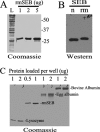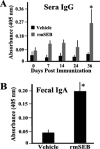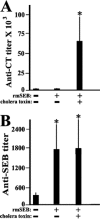Oral vaccine formulations stimulate mucosal and systemic antibody responses against staphylococcal enterotoxin B in a piglet model
- PMID: 20554806
- PMCID: PMC2916245
- DOI: 10.1128/CVI.00078-10
Oral vaccine formulations stimulate mucosal and systemic antibody responses against staphylococcal enterotoxin B in a piglet model
Abstract
Despite the potential for its use as an agent of biowarfare or bioterrorism, no approved vaccine against staphylococcal enterotoxin B (SEB) exists. Nontoxic, mutant forms of SEB have been developed; however, it has been difficult to determine the efficacy of such subunit vaccine candidates due to the lack of superantigen activity of native SEB in rodents and due to the limitations of primate models. Since pigs respond to SEB in a manner similar to that of human subjects, we utilized this relevant animal model to investigate the safety and immunogenicity of a triple mutant of SEB carrying the amino acid changes L45R, Y89A, and Y94A. This recombinant mutant SEB (rmSEB) did not possess superantigen activity in pig lymphocyte cultures. Furthermore, rmSEB was unable to compete with native SEB for binding to pig leukocytes. These in vitro studies suggested that rmSEB could be a safe subunit vaccine. To test this possibility, piglets immunized orally with rmSEB formulations experienced no significant decrease in food consumption and no weight loss during the vaccination regimen. Oral vaccination with 1-mg doses of rmSEB on days 0, 7, 14, and 24 resulted in serum IgG and fecal IgA levels by day 36 that cross-reacted with native SEB. Surprisingly, the inclusion of cholera toxin adjuvant in vaccine formulations containing rmSEB did not result in increased antibody responses compared to formulations using the immunogen alone. Taken together, these studies provide additional evidence for the potential use of nontoxic forms of SEB as vaccines.
Figures





References
-
- Baker, M. D., A. C. Papageorgiou, R. W. Titball, J. Miller, S. White, B. Lingard, J. J. Lee, D. Cavanagh, M. A. Kehoe, J. H. Robinson, and K. R. Acharya. 2002. Structural and functional role of threonine 112 in a superantigen Staphylococcus aureus enterotoxin B. J. Biol. Chem. 277:2756-2762. - PubMed
-
- Bi, S., R. Das, E. Zelazowska, S. Mani, R. Neill, G. D. Coleman, D. C. Yang, R. Hammamieh, J. W. Shupp, and M. Jett. 2009. The cellular and molecular immune response of the weanling piglet to staphylococcal enterotoxin B. Exp. Biol. Med. (Maywood) 234:1305-1315. - PubMed
-
- Boles, J. W., M. L. Pitt, R. D. LeClaire, P. H. Gibbs, E. Torres, B. Dyas, R. G. Ulrich, and S. Bavari. 2003. Generation of protective immunity by inactivated recombinant staphylococcal enterotoxin B vaccine in nonhuman primates and identification of correlates of immunity. Clin. Immunol. 108:51-59. - PubMed
-
- Christopher, G. W., T. J. Cieslak, J. A. Pavlin, and E. M. Eitzen, Jr. 1997. Biological warfare. A historical perspective. JAMA 278:412-417. - PubMed
-
- Coffman, J. D., J. Zhu, J. M. Roach, S. Bavari, R. G. Ulrich, and S. L. Giardina. 2002. Production and purification of a recombinant staphylococcal enterotoxin B vaccine candidate expressed in Escherichia coli. Protein Expr. Purif. 24:302-312. - PubMed
Publication types
MeSH terms
Substances
Grants and funding
LinkOut - more resources
Full Text Sources
Other Literature Sources
Miscellaneous

